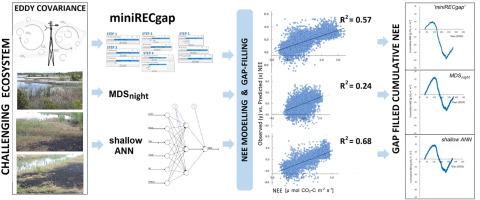Introducing ‘miniRECgap’ R package for simple gap-filling of missing eddy covariance CO2 flux measurements with classic nonlinear environmental response functions via GUI-supported R-scripts (case-study: In-sample gap-filling with ‘miniRECgap’ vs. MDS and an optimised shallow ANN in a ‘challenging’ peatland ecosystem)
IF 4.6
2区 环境科学与生态学
Q1 COMPUTER SCIENCE, INTERDISCIPLINARY APPLICATIONS
引用次数: 0
Abstract
Numerous tools/software exist to gap-fill missing eddy covariance (EC) data, with varying performance depending on study-site dynamics. Disturbed ecosystems like former cutaway-peatlands may be challenging for gap-filling. Researchers using gap-filling spreadsheets may benefit from transitioning to R, but may face challenges if they lack programming skills. To address these, we introduce ‘miniRECgap’, a user-friendly tool in R for effortless gap-filling of EC carbon dioxide flux data using well-known temperature- and light-response functions. ‘miniRECgap’ can model net ecosystem exchange (NEE) via GUI-supported scripts with only five code-lines and minimal inputs. A case-study on one ‘classic’ (forest) and one ‘challenging’ (rehabilitating cutaway-peatland) ecosystem indicated that standard gap-filling (MDS) performed better for the ‘classic’, but not for the ‘challenging’ ecosystem (MDS R2 = 0.24; ‘miniRECgap’ R2 = 0.57). For the rehabilitating-peatland, an optimised shallow Artificial Neural Network outperformed other two approaches (R2 = 0.68). These findings demonstrate the importance of NEE gap-filling for assessing ecosystem-level carbon-dynamics, important for rehabilitating-peatlands.

通过gui支持的R脚本,引入“miniRECgap”R包,用于通过经典非线性环境响应函数对缺失的涡流相关CO2通量测量进行简单的间隙填充(案例研究:在“具有挑战性的”泥炭地生态系统中使用“miniRECgap”与MDS和优化的浅神经网络进行样本间隙填充)
有许多工具/软件可以填补缺失的涡流相关(EC)数据,其性能取决于研究地点的动态。受干扰的生态系统,如以前的切割泥炭地,可能对填补缺口具有挑战性。使用空白填充电子表格的研究人员可能会从过渡到R中受益,但如果他们缺乏编程技能,可能会面临挑战。为了解决这些问题,我们在R中引入了“miniRECgap”,这是一个用户友好的工具,可以使用众所周知的温度和光响应函数轻松填充EC二氧化碳通量数据的间隙。“miniRECgap”可以通过gui支持的脚本对净生态系统交换(NEE)进行建模,只需要5行代码和最少的输入。一个“经典”(森林)和一个“具有挑战性”(开垦泥炭地)生态系统的案例研究表明,标准缺口填充(MDS)在“经典”生态系统中表现更好,而在“具有挑战性”生态系统中表现不佳(MDS R2=0.24;miniRECgap R2 = 0.57)。对于恢复泥炭地,优化后的浅层人工神经网络优于其他两种方法(R2=0.68)。这些发现证明了新能源经济缺口填补对评估生态系统水平碳动态的重要性,对泥炭地的恢复具有重要意义。
本文章由计算机程序翻译,如有差异,请以英文原文为准。
求助全文
约1分钟内获得全文
求助全文
来源期刊

Environmental Modelling & Software
工程技术-工程:环境
CiteScore
9.30
自引率
8.20%
发文量
241
审稿时长
60 days
期刊介绍:
Environmental Modelling & Software publishes contributions, in the form of research articles, reviews and short communications, on recent advances in environmental modelling and/or software. The aim is to improve our capacity to represent, understand, predict or manage the behaviour of environmental systems at all practical scales, and to communicate those improvements to a wide scientific and professional audience.
 求助内容:
求助内容: 应助结果提醒方式:
应助结果提醒方式:


